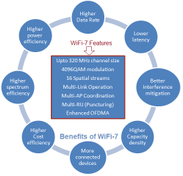WiFi shield vs. Traditonal Encryption: Key Concepts and Differences
Advertisement
In the context of WiFi 7 (i.e. 802.11be), some manufacturers like Huawei has introduced proprietary feature by name “WiFi shield” to enhance security and performance. Let us understand how wifi shield works and how it differs from traditional encryption techniques such as WPA2 and WPA3.
What is WiFi shield?
- This Huawei technology involves sending additional interference signals to prevent malicious users from accessing the network.
- This proprietary technique is designed to protect network from unauthorized users by making it harder for them to establish a stable connection.
- This technique acts as a supplementary security measure which focuses on preventing unauthorized access rather than encrypting data.
Traditional Encryption methods (WPA2/WPA3)
These are standardized protocols developed by the Wi-Fi Alliance to secure wireless networks. These protocols focus on encrypting data transmitted over Wi-Fi to protect against eavesdropping and unauthorized access.
- WPA2 utilizes AES encryption and four way handshake for authentication.
- WPA3 introduces Simultaneous Authentication of Equals (SAE).
Conclusion
In summary, while traditional encryption protocols like WPA2 and WPA3 are essential for securing the data transmitted over Wi-Fi networks, proprietary features like Wi-Fi Shield in Wi-Fi 7 devices serve as additional layers of defense, aiming to prevent unauthorized access through methods such as interference.
 RF
RF


